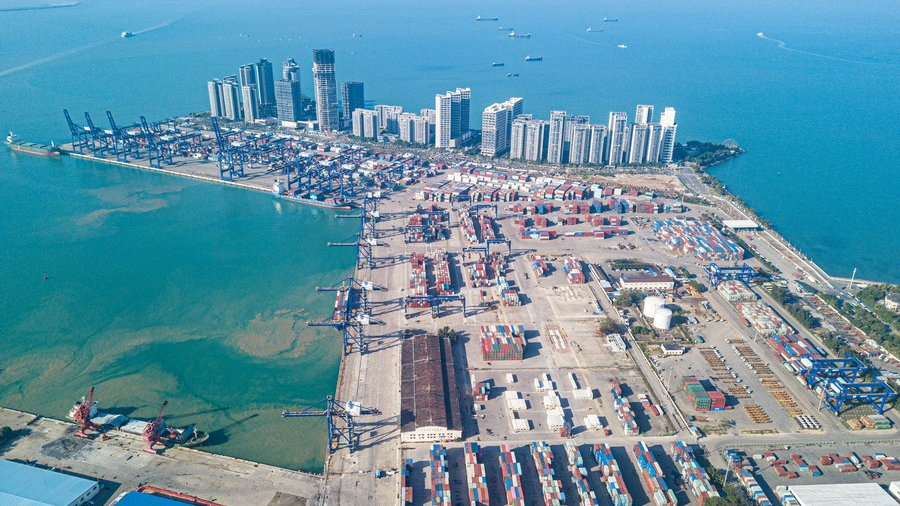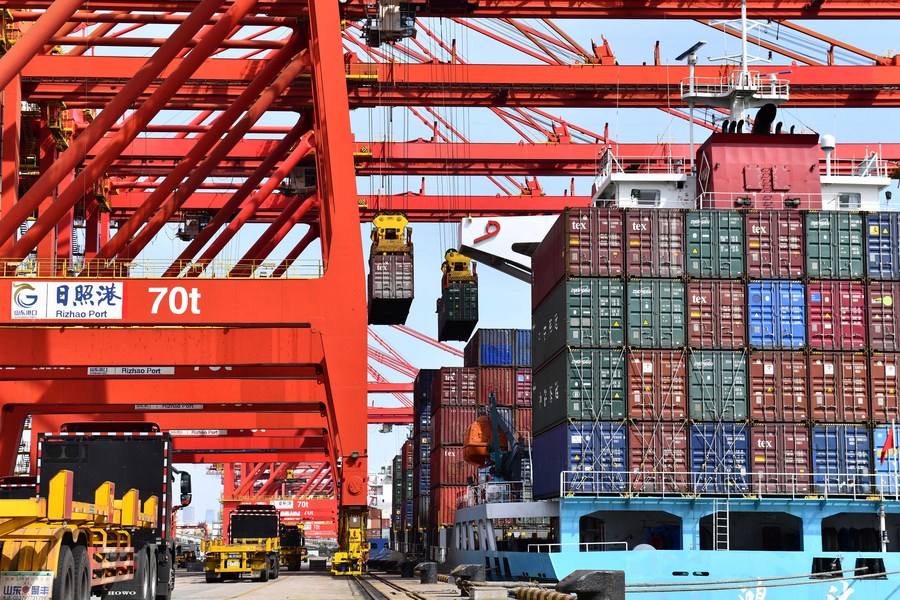
A view of the container terminal of Haikou Port in Haikou, south China's Hainan Province, January 13, 2023. /Xinhua
A view of the container terminal of Haikou Port in Haikou, south China's Hainan Province, January 13, 2023. /Xinhua
Editor's note: Noting that 2023 is the first year for fully implementing the guiding principles from the 20th National Congress of the Communist Party of China, the ongoing "Two Sessions" will grab the world's attention. To better understand China's development blueprint, CGTN has curated the "Towards China's Modernization" series, and this is the seventh piece. Wang Dan is the chief economist at Hang Seng Bank (China). The article reflects the author's opinions and not necessarily the views of CGTN.
Great changes have taken place in the international capital flow. In 2020, China's share of global foreign direct investment (FDI) jumped 23 percent from the pre-pandemic level of 11 percent, while its share for the U.S. dropped from 15 percent to 10 percent. Europe's share of global FDI shrank to 16 percent from the pre-pandemic level of 34 percent.
In 2021, the European share of FDI declined due to the energy crisis, only to show signs of recovery in 2022. In contrast, the U.S. was not affected much by the high energy prices in the same year as it was largely self-sufficient in energy supply. The U.S. economy was overheating, driven by massive policy stimulus. The U.S. share of global FDI in 2021 rebounded sharply to 25 percent, higher than that of China (21 percent).
ASEAN, the South-East Asia's regional club, saw its share of global FDI steadily increase in the past few years. The trend was prominent in 2022. In the first three quarters of 2022, China's FDI dropped sharply, accounting for only 12 percent of the global total. Meanwhile, ASEAN's share increased to 14 percent, surpassing China for the first time.
But it's widely believed that China's share will not stay at such a low level in future years, as the severe influence by the COVID-19 pandemic has come to an end. Chinese companies are outsourcing some of the domestic work to other countries in the region and beyond. The regional trade agreement, Regional Comprehensive Economic Partnership (RCEP), will promote the industrial integration.
Three reasons are behind the transition in Asia's supply chain. The primary cause is to avoid punitive tariffs from the U.S. There was also the mandatory requirement from the buyers on allocating at least some production capacity to regions outside China. For instance, Apple has shifted a proportion of Foxconn's production capacity of electronics parts outside China. Additionally, companies would exploit low labor costs in less developed countries. The China-U.S. relation will have a weighty impact on the future industrial relocation.
But the shift will not shake China's position as a global manufacturing center. To match what China offers, the strength of other Asian countries would have to be combined. The initial capital flow related to production relocation to ASEAN has been moderate, due to insufficiency in local infrastructure and talents. Total delivery time will be longer as companies have to deal with customs and transportation in different countries.

Trucks wait to load containers at a container terminal in Rizhao, east China's Shandong Province, March 28, 2022. /Xinhua
Trucks wait to load containers at a container terminal in Rizhao, east China's Shandong Province, March 28, 2022. /Xinhua
The relocated factories will have to maintain higher level of inventories than their Chinese counterparts. Other Asian countries must develop skills, knowledge value chain over time besides materials supply chain, which they do not have. Based on the developing experience of China's production structure, it will take decades for these countries to achieve that.
For China's domestic opportunities, foreign investors are interested in manufacturing and leasing industries, which accounted for 38 percent of China's FDI in 2021. The share of research and development (R&D) and IT industry in FDI also grew in recent years. This is consistent with China's strategic goals of promoting real economy, as well as services that cater to the needs of manufacturing, such as logistics and industrial designs. Although the "decoupling" in high-tech sector seems inevitable, China remains a linchpin in most other industries downstream. The new-energy supply chain has gained more attention from global investors.
Chinese provinces have entered the competition mode of attracting FDI, yet some have slim chances. In recent years, FDIs are concentrated in coastal China. In 2021, Yangtze River Delta accounted for 42 percent of China's FDI and Guangdong accounted for 16 percent. Their shares have grown significantly in recent years, crowding out investment in other regions. As China climbs up the value chain, there are higher requirement for supporting services and business environment. The explicit cost of doing business in inland China may be low, yet the administrative cost, as well as the difficulty to attract top talents may deter foreign investors.
This year's Two Sessions has vowed to attract more foreign investments. On the path to Chinese modernization, FDI has played a crucial role in providing jobs, technology, and exports. More foreign companies in China focus on servicing the domestic consumer, and thus have higher incentive to transfer technologies. For instance, multinationals such as Schneider (Germany) and Microsoft (U.S.) have established large R&D centers in China. With the localization of foreign investors, we will see more technology transfers and collaborations in the coming years.
(If you want to contribute and have specific expertise, please contact us at opinions@cgtn.com. Follow @thouse_opinions on Twitter to discover the latest commentaries in the CGTN Opinion Section.)